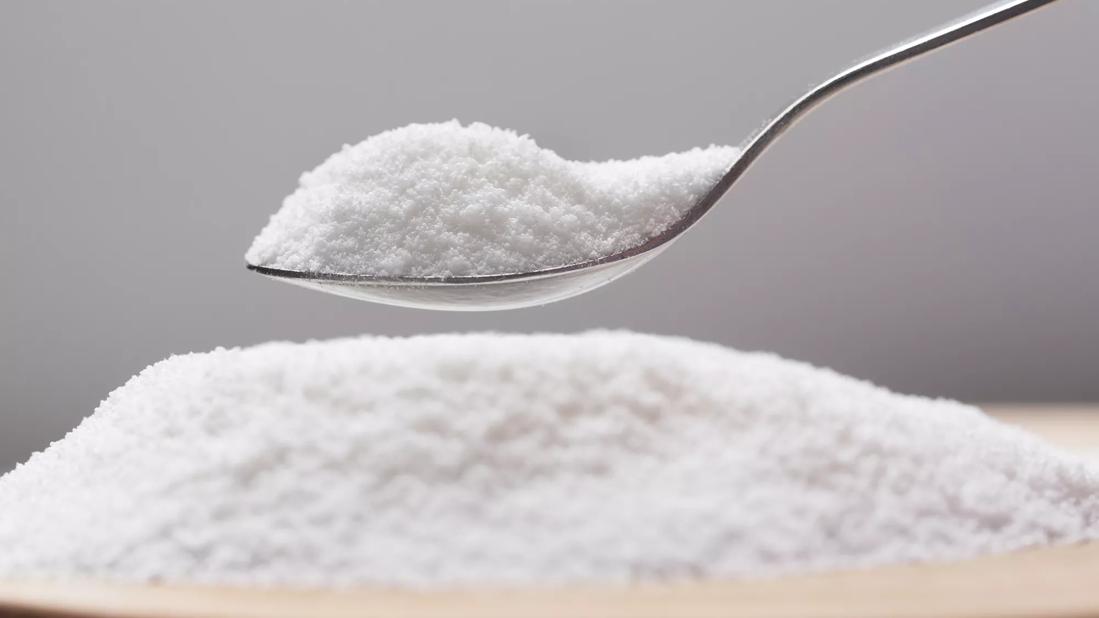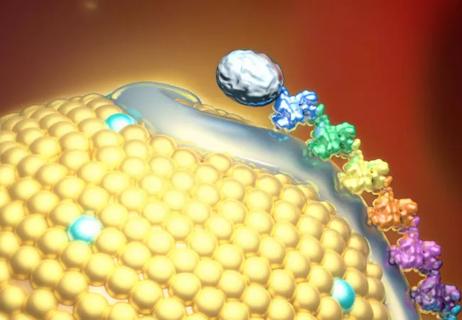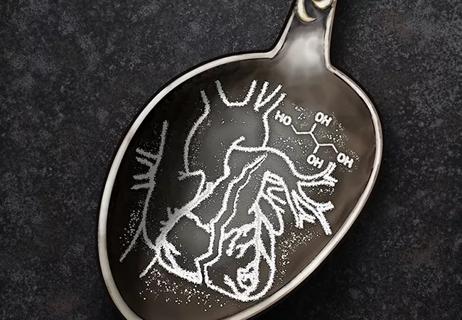Studies reveal increased cardiac events, enhanced platelet reactivity and thrombotic potential

Elevated amounts of the sugar alcohol xylitol are associated with heightened incident risk of major adverse cardiovascular events (MACE) and enhanced platelet reactivity and thrombosis potential, according to new research from Cleveland Clinic with significant public health implications.
Advertisement
Cleveland Clinic is a non-profit academic medical center. Advertising on our site helps support our mission. We do not endorse non-Cleveland Clinic products or services. Policy
A team led by Stanley Hazen, MD, PhD, confirmed the association in a multicomponent investigation — comprising large-scale patient analyses, preclinical functional studies and a clinical intervention study — published in the European Heart Journal.
Last year the same research team found a similar link between cardiovascular risk and another sugar alcohol, erythritol (Nat Med. 2023;29:710-718). The researchers say their new findings reinforce the need for further long-term studies on sugar alcohols, which are increasingly used as zero-calorie sugar substitutes in processed foods marketed as healthier alternatives to sugar-sweetened baked goods or candies.
“This new study again shows the immediate need for investigating sugar alcohols and other sugar substitutes,” says Dr. Hazen, Chair of the Department of Cardiovascular and Metabolic Sciences, Cleveland Clinic Lerner Research Institute, and Co-Section Head of Preventive Cardiology. “This is underscored by the fact that food products with these compounds continue to be recommended for combating conditions like obesity and diabetes despite findings that they appear to actually increase patients’ cardiometabolic risk.”
Xylitol is a five-carbon sugar alcohol naturally found in small quantities in fruits and vegetables. It also is produced endogenously by humans in very small amounts as a side product of glucose metabolism. Over the past 10 to 20 years, it has been manufactured for use at much larger quantities as a sweetener in so-called sugar-free candy, low-sugar baked goods and oral products like toothpaste. It is one of several sugar alcohols that have hit the market in recent years as non-nutritive sweeteners in candies and desserts labeled as “keto friendly,” “diabetes friendly” or “sugar free.”
Advertisement
“Sugar alcohols or polyols are sugar derivatives that can come from natural sources, so they are technically not considered non-sugar or artificial sweeteners,” says study co-author W. H. Wilson Tang, MD, Research Director for Heart Failure and Transplantation in Cleveland Clinic’s Department of Cardiovascular Medicine. “Interestingly, polyols have not been included as added sugars in products’ nutritional labeling, which allows food manufacturers to describe polyol-containing foods as ‘sugar free’ or ‘reduced sugar’ in their claims.
“Xylitol has attracted food manufacturers as a low-calorie, naturally derived sweetening alternative to sucrose,” Dr. Tang continues. “While there have been promotions of potential benefits for human health, supporting data have been sparse and largely focused on tolerability or dental benefits.”
The Cleveland Clinic research team’s investigations of xylitol stem from analyses of fasting blood samples they conducted among over 3,300 adults in the U.S. and Europe who underwent elective cardiac evaluations and were subsequently followed for MACE over the next three years. The blood samples were screened for chemical signatures that predicted future MACE (i.e., myocardial infarction, stroke or death) independent of traditional cardiovascular risk factors.
The analyses included an untargeted metabolomics study in an initial discovery cohort (n = 1,157) that identified circulating levels of a compound tentatively identified as xylitol as being associated with incident MACE risk. A subsequent targeted study in a separate validation cohort (n = 2,149) confirmed xylitol’s association with incident MACE, with an adjusted hazard ratio of 1.57 (95% CI, 1.12-2.21) (P < .01) over three-year follow-up for subjects with the highest tertile of xylitol levels relative to those with levels in the lowest tertile.
Advertisement
“We didn’t set out with a particular interest in xylitol,” Dr. Hazen explains. “We were looking to identify new pathways that contribute to residual cardiovascular disease risk, and xylitol — just like erythritol — happened to track with risk.”
The researchers then conducted preclinical functional studies to directly observe whether xylitol is causally linked to cardiovascular pathogenesis. In vitro studies using human whole blood showed that xylitol substantially enhanced platelet reactivity at levels observed in fasting plasma from the team’s initial cohort studies. “In the presence of xylitol, platelets showed a much lower threshold for clotting,” Dr. Hazen observes.
These in vitro studies were complemented by in vivo mouse studies that demonstrated parallel enhancement of thrombosis formation with xylitol, again at levels equivalent to fasting plasma levels in humans.
The researchers next conducted a human intervention study. They tracked baseline versus postprandial platelet activity from 10 healthy volunteers who ingested a drink sweetened with 30 g of xylitol (roughly equivalent to the amount in a single scoop of keto-friendly ice cream). Plasma levels of xylitol increased 1,000-fold in these subjects within 30 minutes, and every measure of platelet responsiveness significantly increased immediately following ingestion in every subject. Xylitol was rapidly excreted, returning to near-baseline (fasting) levels within six hours after ingestion.
“This suggests that the overnight fasting plasma levels of xylitol seen in our large observational cohort represent variations in endogenous levels of xylitol, not levels impacted by food consumption,” Dr. Hazen notes. He adds that this underscores just how great the clotting risk from food-related elevations in plasma xylitol may be, given how greatly the xylitol levels that are added to foods dwarf endogenous levels.
Advertisement
“It’s not hard to imagine that someone with diabetes or cardiovascular disease could eat products containing xylitol every day, throughout the day,” Dr. Hazen says. “So that risk would remain if they continued to consume xylitol. The people who are most at risk for clotting events like heart attack and stroke are the very same people who are most likely to be ingesting xylitol at high levels and further increasing that risk without knowing it.”
Notably, Dr. Hazen points out that the thrombotic risks of xylitol ingestion are likely to be limited to ingestion in large amounts, like those added to food products. “We know that xylitol in oral care products like toothpaste and mouthwash can help fight cavities,” he says. “Since people don’t ingest those products in more than trace amounts, they should be safe to use.”
“Our new findings parallel our recent observations with erythritol,” Dr. Tang observes. “Both highlight the need for rigorously conducted prospective clinical trials with sufficient duration and clinically relevant endpoints to establish the cardiovascular and metabolic safety — or risk — of these widely consumed sugar substitutes in direct comparison to consuming sugar itself.”
“The effect we observed was significant, and it was confirmed across many different types of studies,” Dr. Hazen adds. “This is a health concern on a population scale. I hope this research and future studies will trigger a reappraisal of regulatory guidelines around sugar substitutes. We need more research on this topic so we can make sure we’re not inadvertently urging people to reach for something they think is a healthy choice when it’s not.”
Advertisement
Dr. Hazen notes that measuring sugar alcohols in blood is difficult, however, because their structures are nearly identical to each other. In fact, before performing the clinical validation cohort studies, his research team had to develop a test to accurately measure xylitol — a test that other teams can now use to confirm circulating xylitol levels.
Meanwhile, until further clarifying research or regulatory guidance is forthcoming, Dr. Hazen advises his patients to avoid all highly processed foods labeled as keto-friendly or diabetic-friendly. “I would argue that sugar or honey, in moderation, are actually better alternatives to these sugar alcohols, even for people with diabetes,” he says. “But people, especially those with diabetes, need to be vigilant about their glucose levels and keep their intake low.”
Advertisement

Cleveland Clinic pioneers a new paradigm in cardiovascular care delivery

Site visits offer firsthand lessons in clinical and operational excellence in cardiovascular care

Evolving thinking on when and how to treat brain aneurysms and AVMs

Phase 3 TANDEM study may help pave way to first approval of a CETP inhibitor

Yet 21.4% of tested individuals had Lp(a) elevation

Phase 2 trial of zerlasiran yields first demonstration of longer effect with each dose of an siRNA

Cancer drug helps treat decades-long symptoms in patient with complicated lymphatic issue

Study authors urge reevaluation of the sweetener’s safety designation by food regulators